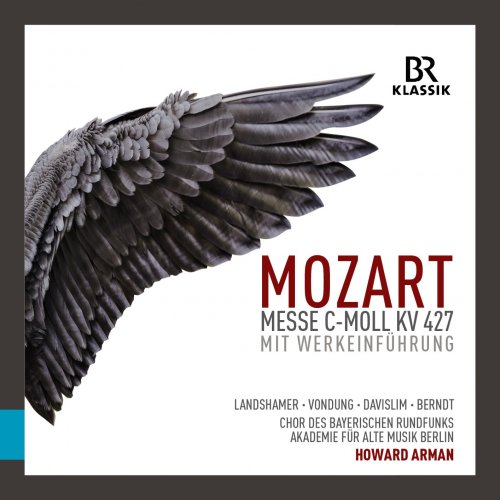Chor des Bayerischen Rundfunks, Münchner Rundfunkorchester & Howard Arman - Mozart: Messe in C-Moll, K. 427 "Große Messe" (Mit Werkeinführung) [Live] (2018) [Hi-Res]

Artist: Chor des Bayerischen Rundfunks, Münchner Rundfunkorchester & Howard Arman
Title: Mozart: Messe in C-Moll, K. 427 "Große Messe" (Mit Werkeinführung) [Live]
Year Of Release: 2018
Label: BR-Klassik
Genre: Classical
Quality: flac lossless / flac 24bits - 48.0kHz +booklet
Total Time: 02:03:43
Total Size: 567 mb / 1.1 gb
WebSite: Album Preview
TracklistTitle: Mozart: Messe in C-Moll, K. 427 "Große Messe" (Mit Werkeinführung) [Live]
Year Of Release: 2018
Label: BR-Klassik
Genre: Classical
Quality: flac lossless / flac 24bits - 48.0kHz +booklet
Total Time: 02:03:43
Total Size: 567 mb / 1.1 gb
WebSite: Album Preview
---------
CD1
01. Messe in C-Moll, K. 427 "Große Messe" (Reconstructed by C. Kemme): I. Kyrie [Live]
02. Messe in C-Moll, K. 427 "Große Messe" (Reconstructed by C. Kemme): IIa. Gloria in excelsis Deo [Live]
03. Messe in C-Moll, K. 427 "Große Messe" (Reconstructed by C. Kemme): IIb. Laudamus te [Live]
04. Messe in C-Moll, K. 427 "Große Messe" (Reconstructed by C. Kemme): IIc. Gratias agimus tibi [Live]
05. Messe in C-Moll, K. 427 "Große Messe" (Reconstructed by C. Kemme): IId. Domine Deus [Live]
06. Messe in C-Moll, K. 427 "Große Messe" (Reconstructed by C. Kemme): IIe. Qui tollis [Live]
07. Messe in C-Moll, K. 427 "Große Messe" (Reconstructed by C. Kemme): IIf. Quoniam tu solus [Live]
08. Messe in C-Moll, K. 427 "Große Messe" (Reconstructed by C. Kemme): IIg. Jesu Christe-Cum Santo Spiritu [Live]
09. Messe in C-Moll, K. 427 "Große Messe" (Reconstructed by C. Kemme): IIIa. Credo in unum Deum [Live]
10. Messe in C-Moll, K. 427 "Große Messe" (Reconstructed by C. Kemme): IIIb. Et incarnatus est [Live]
11. Messe in C-Moll, K. 427 "Große Messe" (Reconstructed by C. Kemme): IV. Sanctus-Osanna [Live]
12. Messe in C-Moll, K. 427 "Große Messe" (Reconstructed by C. Kemme): V. Benedictus-Osanna [Live]
CD2
01. Wege zur Musik aus der Messe in C-Moll, Teil 1 "Der herrliche Torso": Junger Ehemann und werdender Vater
02. Wege zur Musik aus der Messe in C-Moll, Teil 1 "Der herrliche Torso": Die Votivgabe
03. Wege zur Musik aus der Messe in C-Moll, Teil 1 "Der herrliche Torso": Lücken und Fragmente
04. Wege zur Musik aus der Messe in C-Moll, Teil 1 "Der herrliche Torso": Ein tugendhaftes und gefälliges Weib
05. Wege zur Musik aus der Messe in C-Moll, Teil 1 "Der herrliche Torso": Was ist Aufklärung?
06. Wege zur Musik aus der Messe in C-Moll, Teil 2 "Mozart auf Freiersfüßen": Emanzipation, Erfolg und Neuanfang
07. Wege zur Musik aus der Messe in C-Moll, Teil 2 "Mozart auf Freiersfüßen": Liebe und Fugen
08. Wege zur Musik aus der Messe in C-Moll, Teil 2 "Mozart auf Freiersfüßen": Nichts als Händel und Bach
09. Wege zur Musik aus der Messe in C-Moll, Teil 2 "Mozart auf Freiersfüßen": Freundschaften und Opernpläne
10. Wege zur Musik aus der Messe in C-Moll, Teil 2 "Mozart auf Freiersfüßen": Arien und Familienkonflikte
11. Wege zur Musik aus der Messe in C-Moll, Teil 3 "Salzburg und die Nachwelt": Salzburger Tragödie
12. Wege zur Musik aus der Messe in C-Moll, Teil 3 "Salzburg und die Nachwelt": Erstaufführung zu Sankt Peter
13. Wege zur Musik aus der Messe in C-Moll, Teil 3 "Salzburg und die Nachwelt": Parodie im Burgtheater
14. Wege zur Musik aus der Messe in C-Moll, Teil 3 "Salzburg und die Nachwelt": Frau Witwe Mozart
15. Wege zur Musik aus der Messe in C-Moll, Teil 3 "Salzburg und die Nachwelt": Gleich einer Reliquie
Written in 1782, Mozart's Mass in C minor - although incomplete – ranks as one of the outstanding Mass settings in European music history. The very recent reconstruction/completion of the Mass by Clemens Kemme in the spring of 2018 confines itself to the original sources, avoiding any arbitrary additions. The work was recorded in this critically acclaimed version for the Bayerischer Rundfunk during the summer of 2018, and conducted by Howard Arman. This album is thus the first recording of the definitive version of this new and intelligently edited reconstruction of Mozart's Mass in C minor. An introduction to the work is also included, enabling this masterpiece to be approached from new perspectives. In Vienna in the summer of 1782, Mozart started writing a new Mass despite having apparently received no commission to do so. On August 4, 1782 he married Constanze Mozart, and from his correspondence it appears that he had made himself a promise to “have a newly-composed mass performed in Salzburg if he brought her there as his wife.” The work may have been performed on October 26, 1783 in St. Peter's Church in Salzburg, with Constanze as the soprano soloist; concrete evidence of such a performance is however lacking. Nevertheless, the Mass can probably be seen as a kind of votive offering for Constanze. The fact that the work was not completed may be due to the church music reforms implemented by the Emperor Joseph II, who preferred sacred music to be performed on a smaller scale. In 1785, Mozart eventually reworked the “Kyrie" and "Gloria" from the mass for his cantata Davide penitente.

![Eddie Kirk Quartet - The Analog Sessions I (2025) [Hi-Res] Eddie Kirk Quartet - The Analog Sessions I (2025) [Hi-Res]](https://www.dibpic.com/uploads/posts/2025-12/1765429487_z6ldhaanme7f8_600.jpg)
![Chewing, Dave Harrington, Ryan Hahn, Spencer Zahn - Quintet (Live in Los Angeles) (2025) [Hi-Res] Chewing, Dave Harrington, Ryan Hahn, Spencer Zahn - Quintet (Live in Los Angeles) (2025) [Hi-Res]](https://img.israbox.com/img/2025-12/12/owakjkfg0whflv2rzyocno89p.jpg)




![The Mood Mosaic - Funk 'n' Roll (2025) [Hi-Res] The Mood Mosaic - Funk 'n' Roll (2025) [Hi-Res]](https://www.dibpic.com/uploads/posts/2025-12/1765495597_fei4b1bbm7qjr_600.jpg)
![Jessica Williams - Blue Abstraction: Prepared Piano Project 1985–1987 (2025) [Hi-Res] Jessica Williams - Blue Abstraction: Prepared Piano Project 1985–1987 (2025) [Hi-Res]](https://www.dibpic.com/uploads/posts/2025-12/1765198417_a0174413742_10.jpg)